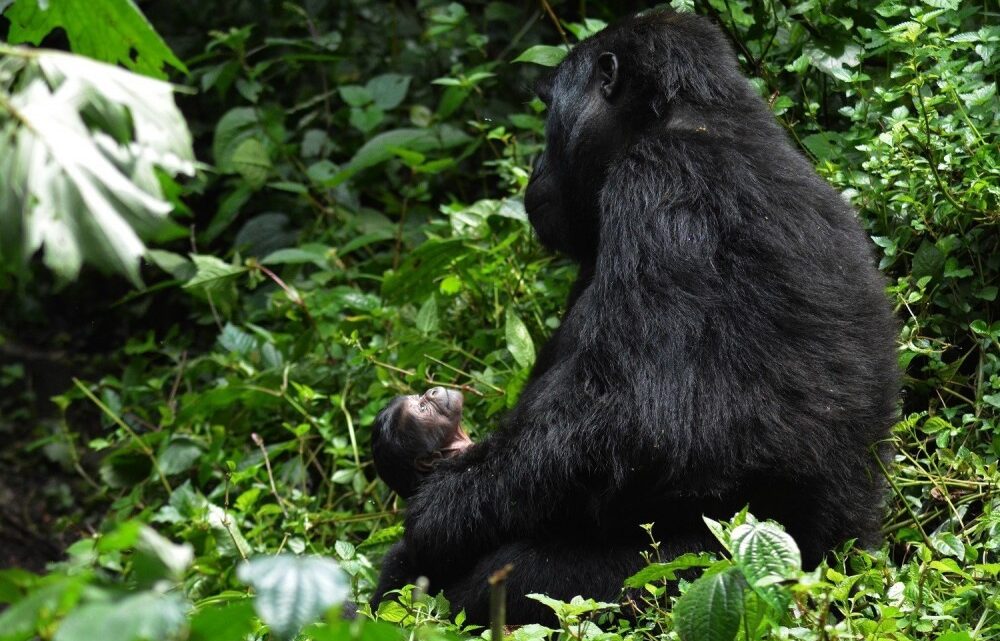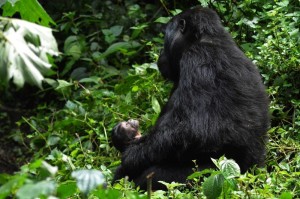
Uganda Welcomes Three Infant Mountain Gorillas
26/10/2016Questo articolo è stato letto 9996 volte!

Uganda’s newest mountain gorilla, named “Masiko” or “Hope”, was born in Bwindi Impenetrable National Park in late September. Uganda is home to approximately 480 mountain gorillas, more than half the world’s remaining population. (PRNewsFoto/Uganda Tourism Board)
Uganda Welcomes Three Infant Mountain Gorillas
Critically endangered population continues growth due to proactive conservation efforts
Approximately 480 mountain gorillas, more than half the world’s population of this critically endangered creature (a subspecies of the eastern gorilla), reside in the dense forests of southwestern Uganda, and that number has grown with the recent birth of three infants since mid-August. Adventurous visitors tracking the habituated Habinyanja gorilla family in Bwindi Impenetrable National Park spotted the newest arrival in late September.
Uganda has 12 habituated mountain gorilla families (11 in Bwindi and one in Mgahinga Gorilla National Park), and the opportunity to track them in their natural habitat tops the bucket lists of wildlife enthusiasts and intrepid travelers worldwide. Researchers began the Habinyanja family’s two-year habituation process in 1997, spending time with them daily until they became at ease around humans. The other two infants belong to the Bushaho and Bikyirigi families, which are currently undergoing habituation and cannot yet be tracked by visitors.
Uganda Wildlife Authority: Conservation in Action
The number of mountain gorillas in Bwindi has progressively increased over the last 20 years according to four censuses taken to monitor population size. Despite this growth, mountain gorillas remain threatened due to issues such as poaching, habitat loss, and encroachment by humans. Government organizations like the Uganda Wildlife Authority (UWA) proactively combat these problems to protect the gorillas and their forest home. The UWA, founded in 1996, manages and patrols Uganda’s 10 national parks and is dedicated to the conservation, economic development, and sustainable management of the country’s wildlife protected areas.
From Veterinarians to Tourists: Keeping Gorillas Healthy
Disease and respiratory infections are also threats to Uganda’s mountain gorilla population. Gorillas are susceptible to many of the same illnesses as humans, and keeping them healthy is critically important. Visitors to Bwindi and Mgahinga are required to stay 21 feet from the gorillas at all times to prevent the passing of germs and are advised not to track gorillas if they are experiencing a cold or other signs of infection. UWA rangers monitor the health and well-being of gorilla families on an ongoing basis. When a gorilla is in need of care, the UWA calls upon Gorilla Doctors, a partnership of the UC Davis Mountain Gorilla Veterinary Project and the UC Davis Wildlife Health Center with staff on the ground in Uganda.
Tracking Permits: Funding Future Generations
Permits priced at US$600 per person in high season are required to track the habituated gorillas. A portion of the tracking permit fee is used to fund the salaries of park rangers and anti-poaching measures, and 20% of the fee goes to the local communities surrounding Bwindi and Mgahinga, which often equals upwards of US$1 millioneach year to support community growth and education.
Community Education: A Grassroots Approach
When members of Uganda’s communities learn more about the gorillas and begin to reap the economic and employment benefits created by gorilla tracking, their relationship with the mountain gorillas typically begins to shift. They become less likely to engage in poaching, and human-wildlife conflicts are reduced. Teenagers and young adults in the communities have the opportunity to serve as gorilla tracking assistants, working to help visitors navigate the trails and paths required to reach the gorillas. Through this process, they develop a new understanding of the gorillas, which they then share with their friends and family. In some cases, poachers from these local communities have even become park rangers dedicated to maintaining the gorillas’ safety.
“Uganda’s wildlife and national parks are our most precious natural resources, and we must all do our part to support their conservation,” said UWA Executive Director Andrew Seguya. “I am proud that the UWA plays such an important role in ensuring that Uganda’s mountain gorillas, giraffes, rhinos, and other animals will continue to thrive for generations to come.”
Editor Note: High-res images can be downloaded here.
ABOUT UGANDA
Known as the “Pearl of Africa,” Uganda is located in East Africa and offers some of the continent’s most diverse wildlife viewing, dramatic landscapes, and immersive cultural experiences. Uganda is home to more than half the world’s population of endangered mountain gorillas, and trekking to observe these gentle giants in Bwindi Impenetrable Forest is one of the world’s top “bucket list” travel activities. Safari opportunities abound in savanna, forest, and wetland settings throughout 10 national parks, where visitors can come face to face with “The Big Five” – lion, leopard, rhino, elephant, and buffalo – as well as giraffe, zebra, chimpanzee, hippopotamus, crocodile, and more than half of all bird species found in Africa. Among Uganda’s extraordinary natural attractions are the snow-capped Rwenzori Mountains; expansive Lake Victoria, which forms the source of the Nile River; and Murchison Falls National Park. Air service to Uganda’s Entebbe International Airport is available on carriers including Delta Air Lines/KLM Royal Dutch Airlines, Brussels Airlines, Qatar Airways, Emirates Airlines, Turkish Airlines, Etihad Airways, South African Airways, EgyptAir and Ethiopian Airlines. For more information, please visit www.visituganda.com.


